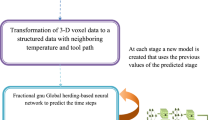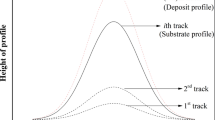Abstract
In semiconductor fabrication, the deposition process generates layers of materials to realize insulating and conducting functionality. The uniformity of the deposited thin film layers’ thickness is crucial to create high-performance semiconductor devices. Tuning fabrication process parameters (e.g., for evenly distributed gas flow on the semiconductor wafer) is one of the dominant factors that affect film uniformity, as evidenced by both experimental and numerical studies. Conventional trial and error methods employed to change and test a range of fabrication conditions are time-consuming, and few studies have explored the effect of changing the geometry of hardware components, such as the showerhead. Here, we present a design optimization of the showerhead for flow uniformity based on numerical simulation data using machine learning surrogate models. Accurate machine learning models and optimization algorithms are developed and implemented to achieve 10% more flow uniformity compared to a benchmark traditional showerhead design. Moreover, the developed Bayesian optimization method saves 10-fold computational cost in reaching the optimal showerhead designs compared to conventional approaches. This machine learning enabled optimization platform shows promising results which could be implemented for other optimization problems in various manufacturing systems such as semiconductor fabrication and additive manufacturing.






Similar content being viewed by others
References
Chandrasekharan, R., Sangplung, S., Swaminathan, S., Pasquale, F., Kang, H., Lavoie, A., Augustyniak, E., Sakiyama, Y., Baldasseroni, C., & Varadarajan, S. (2019). Low volume showerhead with faceplate holes for improved flow uniformity.
Chen, W. C., Lee, A. H. I., Deng, W. J., & Liu, K. Y. (2007). 2007/05/01/). The implementation of neural network for semiconductor PECVD process. Expert Systems with Applications, 32(4), 1148–1153. https://doi.org/10.1016/j.eswa.2006.02.013.
Chen, C. T., & Gu, G. X. (2021). Learning hidden elasticity with deep neural networks. Proceedings of the National Academy of Sciences, 118(31).
DePinto, G., & Wilson, J. (1990). Optimization of LPCVD silicon nitride deposition process by use of designed experiments. IEEE/SEMI Conference on Advanced Semiconductor Manufacturing Workshop
Ding, Y., Zhang, Y., Ren, Y. M., Orkoulas, G., & Christofides, P. D. (2019). 2019/11/01/). Machine learning-based modeling and operation for ALD of SiO2 thin-films using data from a multiscale CFD simulation. Chemical Engineering Research and Design, 151, 131–145. https://doi.org/10.1016/j.cherd.2019.09.005.
Galton, F. (1886). Regression towards mediocrity in hereditary stature. The Journal of the Anthropological Institute of Great Britain and Ireland, 15, 246–263.
Gongora, A. E., Xu, B., Perry, W., Okoye, C., Riley, P., Reyes, K. G., Morgan, E. F., & Brown, K. A. (2020). A bayesian experimental autonomous researcher for mechanical design. Science advances, 6(15), eaaz1708.
Gongora, A. E., Snapp, K. L., Whiting, E., Riley, P., Reyes, K. G., Morgan, E. F., & Brown, K. A. (2021). Using simulation to accelerate autonomous experimentation: a case study using mechanics. Iscience, 24(4), 102262.
Janai, J., Güney, F., Behl, A., & Geiger, A. (2020). Computer vision for autonomous vehicles: problems, datasets and state of the art. Foundations and Trends® in Computer Graphics and Vision, 12(1–3), 1–308.
Jin, Z., Zhang, Z., Demir, K., & Gu, G. X. (2020). Machine learning for advanced additive manufacturing. Matter, 3(5), 1541–1556.
Jin, Z., Zhang, Z., Ott, J., & Gu, G. X. (2021). Precise localization and semantic segmentation detection of printing conditions in fused filament fabrication technologies using machine learning. Additive Manufacturing, 37, 101696.
Jumper, J., Evans, R., Pritzel, A., Green, T., Figurnov, M., Ronneberger, O., Tunyasuvunakool, K., Bates, R., Žídek, A., & Potapenko, A. (2021). Highly accurate protein structure prediction with AlphaFold. nature, 596(7873), 583–589.
Lee, S., Zhang, Z., & Gu, G. X. (2022). Generative machine learning algorithm for lattice structures with superior mechanical properties. Materials Horizons, 9(3), 952–960.
Li, J., Fei, Z., Xu, Y., Wang, J., Fan, B., Ma, X., & Wang, G. (2018). Study on the optimization of the deposition rate of planetary GaN-MOCVD films based on CFD simulation and the corresponding surface model. Royal Society Open Science, 5(2), 171757. https://doi.org/10.1098/rsos.171757.
Liao, C. C., Hsiau, S. S., & Chuang, T. C. (2018). 2018/01/01). Modeling and designing a new gas injection diffusion system for metalorganic chemical vapor deposition. Heat and Mass Transfer, 54(1), 115–123. https://doi.org/10.1007/s00231-017-2110-8.
Pedregosa, F., Varoquaux, G., Gramfort, A., Michel, V., Thirion, B., Grisel, O., Blondel, M., Prettenhofer, P., Weiss, R., & Dubourg, V. (2011). Scikit-learn: machine learning in Python. The Journal of Machine Learning Research, 12, 2825–2830.
Quinonero-Candela, J., & Rasmussen, C. E. (2005). A unifying view of sparse approximate gaussian process regression. The Journal of Machine Learning Research, 6, 1939–1959.
Selep, M. J., Borth, A. J., Wiltse, J. M., Slevin, D. M., & Madsen, E. (2019). Chemical vapor deposition shower head for uniform gas distribution.
Silver, D., Huang, A., Maddison, C. J., Guez, A., Sifre, L., Van Den Driessche, G., Schrittwieser, J., Antonoglou, I., Panneershelvam, V., & Lanctot, M. (2016). Mastering the game of go with deep neural networks and tree search. nature, 529(7587), 484–489.
Snoek, J., Larochelle, H., & Adams, R. P. (2012). Practical bayesian optimization of machine learning algorithms.Advances in neural information processing systems, 25.
Stigler, S. M. (1974). Gergonne’s 1815 paper on the design and analysis of polynomial regression experiments. Historia Mathematica, 1(4), 431–439.
Xia, H., Xiang, D., & Mou, P. (2014). Simulation-Based optimization of a Vector Showerhead System for the control of Flow Field Profile in a Vertical Reactor Chamber. Advances in Mechanical Engineering, 6, 525102. https://doi.org/10.1155/2014/525102.
Yu, C. H., Wu, C. Y., & Buehler, M. J. (2022). Deep learning based design of porous graphene for enhanced mechanical resilience. Computational Materials Science, 206, 111270.
Zhang, Z., Jin, Z., & Gu, G. X. (2022). Efficient pneumatic actuation modeling using hybrid physics-based and data-driven framework. Cell Reports Physical Science, 3(4), 100842.
Acknowledgements
This work used the Extreme Science and Engineering Discovery Environment (XSEDE) Bridges system, which is supported by National Science Foundation (Fund number ACI-1548562). The authors acknowledge support from the National Science Foundation (Fund Number: DMREF-2119276) and Lam Research Unlock Ideas Program.
Author information
Authors and Affiliations
Corresponding author
Additional information
Publisher’s Note
Springer Nature remains neutral with regard to jurisdictional claims in published maps and institutional affiliations.
Rights and permissions
Springer Nature or its licensor (e.g. a society or other partner) holds exclusive rights to this article under a publishing agreement with the author(s) or other rightsholder(s); author self-archiving of the accepted manuscript version of this article is solely governed by the terms of such publishing agreement and applicable law.
About this article
Cite this article
Jin, Z., Lim, D.D., Zhao, X. et al. Machine learning enabled optimization of showerhead design for semiconductor deposition process. J Intell Manuf 35, 925–935 (2024). https://doi.org/10.1007/s10845-023-02082-8
Received:
Accepted:
Published:
Issue Date:
DOI: https://doi.org/10.1007/s10845-023-02082-8




